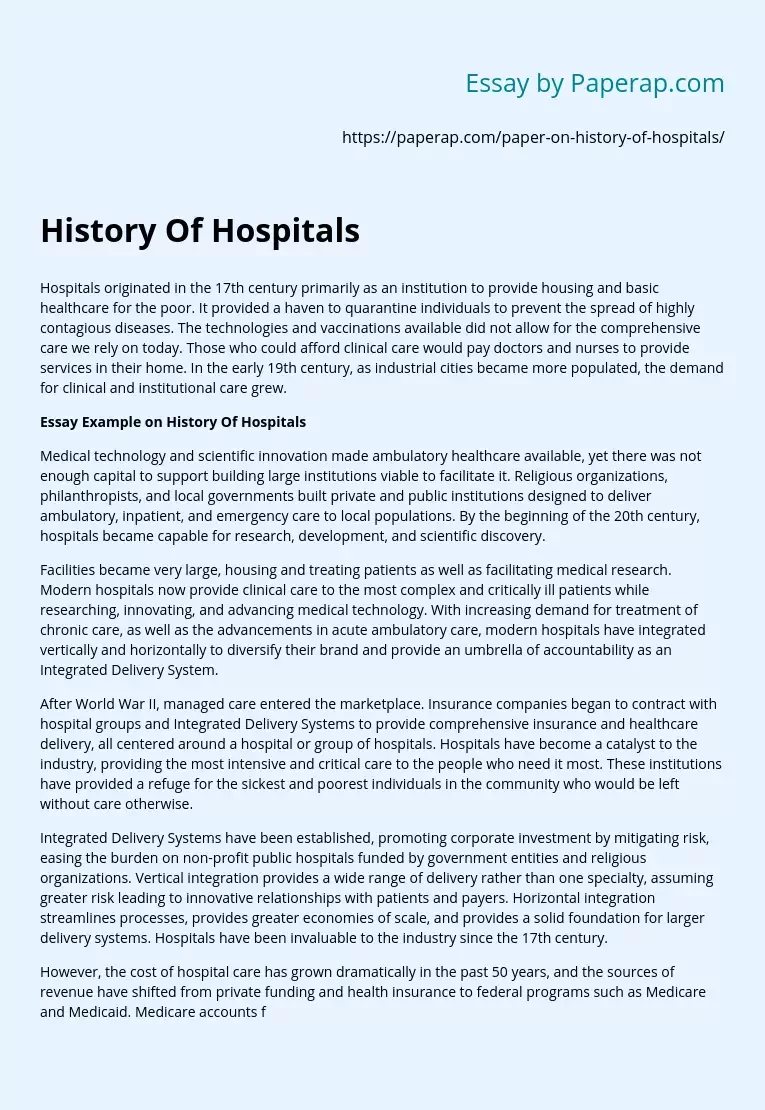History Of Hospitals as an Insitution
Hospitals originated in the 17th century primarily as an institution to provide housing and basic healthcare for the poor. It provided a haven to quarantine individuals to prevent the spread of highly contagious diseases. The technologies and vaccinations available did not allow for the comprehensive care we rely on today. Those who could afford clinical care would pay doctors and nurses to provide services in their home. In the early 19th century, as industrial cities became more populated, the demand for clinical and institutional care grew.
History Of Hospitals and Healthcare
Medical technology and scientific innovation made ambulatory healthcare available, yet there was not enough capital to support building large institutions viable to facilitate it. Religious organizations, philanthropists, and local governments built private and public institutions designed to deliver ambulatory, inpatient, and emergency care to local populations. By the beginning of the 20th century, hospitals became capable for research, development, and scientific discovery.
Facilities became very large, housing and treating patients as well as facilitating medical research.
Modern hospitals now provide clinical care to the most complex and critically ill patients while researching, innovating, and advancing medical technology. With increasing demand for treatment of chronic care, as well as the advancements in acute ambulatory care, modern hospitals have integrated vertically and horizontally to diversify their brand and provide an umbrella of accountability as an Integrated Delivery System.
After World War II, managed care entered the marketplace. Insurance companies began to contract with hospital groups and Integrated Delivery Systems to provide comprehensive insurance and healthcare delivery, all centered around a hospital or group of hospitals.
Hospitals have become a catalyst to the industry, providing the most intensive and critical care to the people who need it most. These institutions have provided a refuge for the sickest and poorest individuals in the community who would be left without care otherwise.
Integrated Delivery Systems have been established, promoting corporate investment by mitigating risk, easing the burden on non-profit public hospitals funded by government entities and religious organizations. Vertical integration provides a wide range of delivery rather than one specialty, assuming greater risk leading to innovative relationships with patients and payers. Horizontal integration streamlines processes, provides greater economies of scale, and provides a solid foundation for larger delivery systems. Hospitals have been invaluable to the industry since the 17th century.
However, the cost of hospital care has grown dramatically in the past 50 years, and the sources of revenue have shifted from private funding and health insurance to federal programs such as Medicare and Medicaid. Medicare accounts for nearly a third of all hospital expenditures, whose fee schedules and DRG payment model do not promote quality, preventative care. The decrease in the number of large hospitals over the past few decades has yielded to a growth in smaller, for-profit specialty hospitals which places a greater burden on community hospitals that provide costly emergency and complex care.
The Hill-Burton Act of 1946 provided federal funding for hospitals in middle and lower class areas with caveats and regulations for how care was delivered. Hospitals that received funding were required to provide uncompensated care to those who could not afford it, placing a large burden of risk to the facility. The Public Service Health Act reinforced these regulations by broadening the scope of “inability to pay”, leading to an increase in lawsuits and administrative costs to the already large hospital budgets.
Lean management with implementation in information technology are key to hospitals’ future success as a cornerstone to integrated delivery systems. In order for hospitals to be effective as we progress into the 21st century, a building structure should facilitate individual doctors in performing their various activities. But at the same time, it must not complicate the indispensable cooperation and communication between specialists and multidisciplinary diagnosis and treatment of patients.
Structure must contribute to efficiency and transparency of processes involving different patient categories, but without fragmenting the work processes of doctors too much and decentralizing technology to an unmanageable scale (Geisler et al 158). References Geisler, Eliezer, Koos Krabbendam, and Roel Schuring. Technology, Health Care, and Management in the Hospital of the Future. Greenwood Publishing Group, 2003. 158. eBook. Williams, Stephen J. Introduction to Health Services. 7th ed. Clifton Park, NY: Thomson Delmar Learning, 2008. 183-97. Print.
History Of Hospitals as an Insitution. (2019, Nov 27). Retrieved from https://paperap.com/paper-on-history-of-hospitals/

